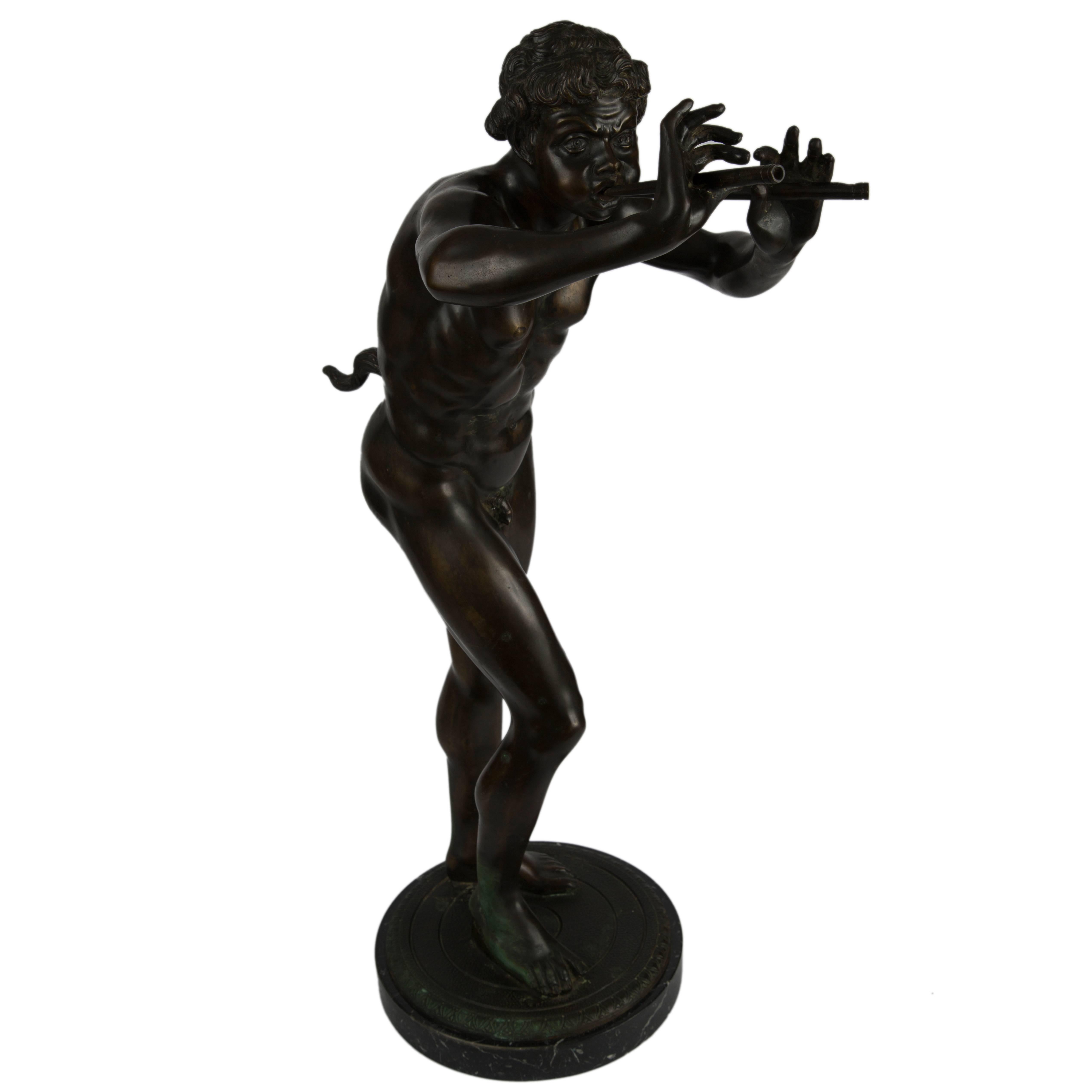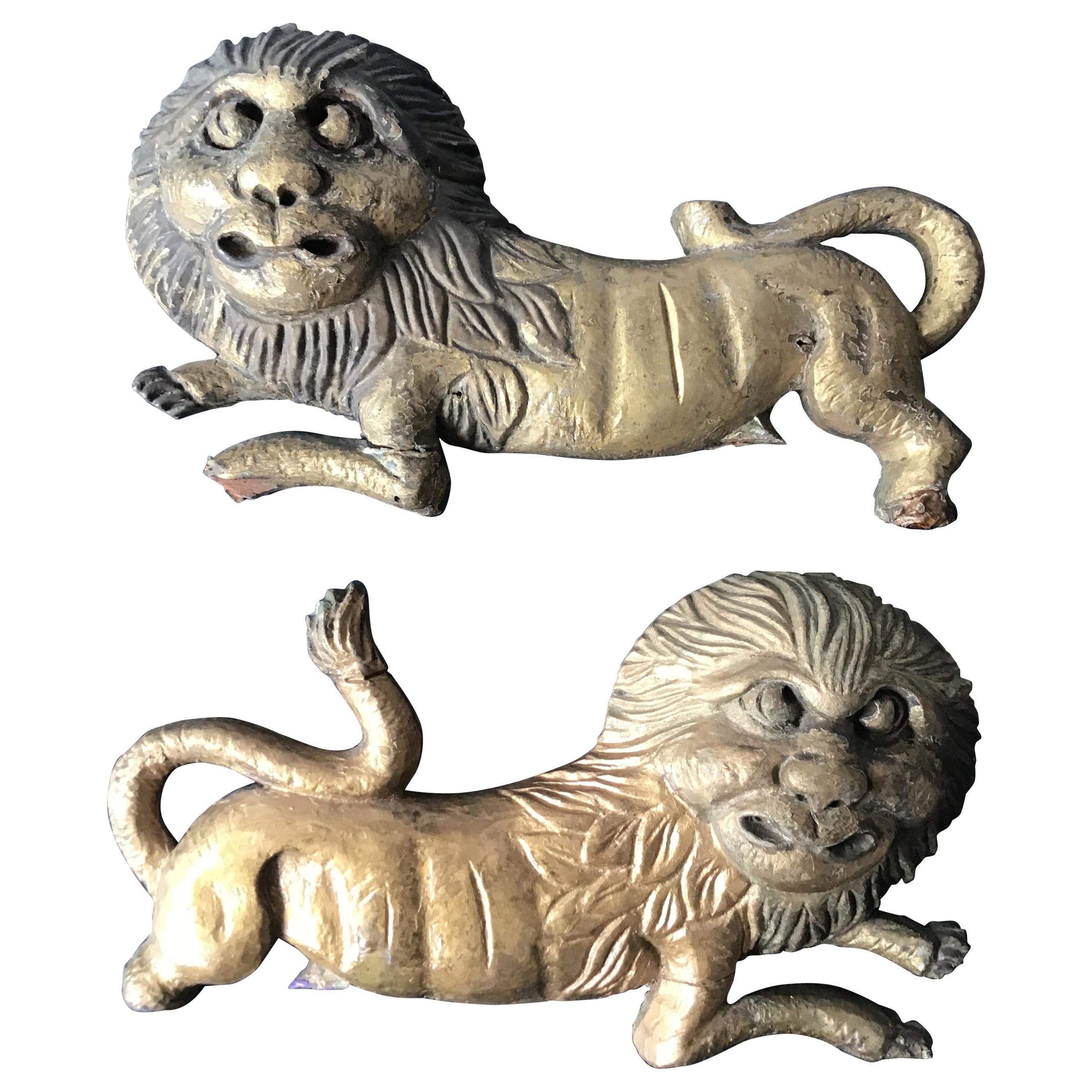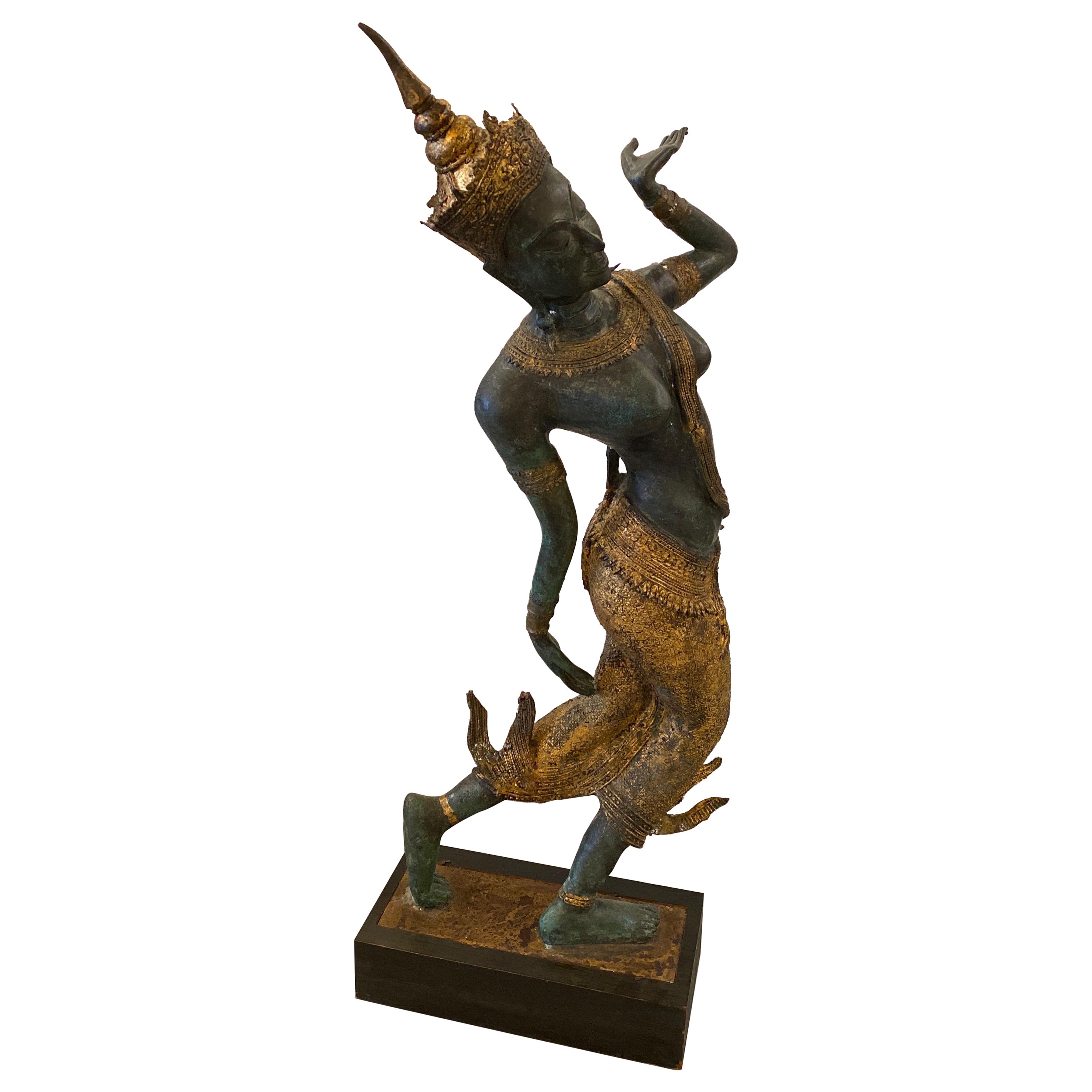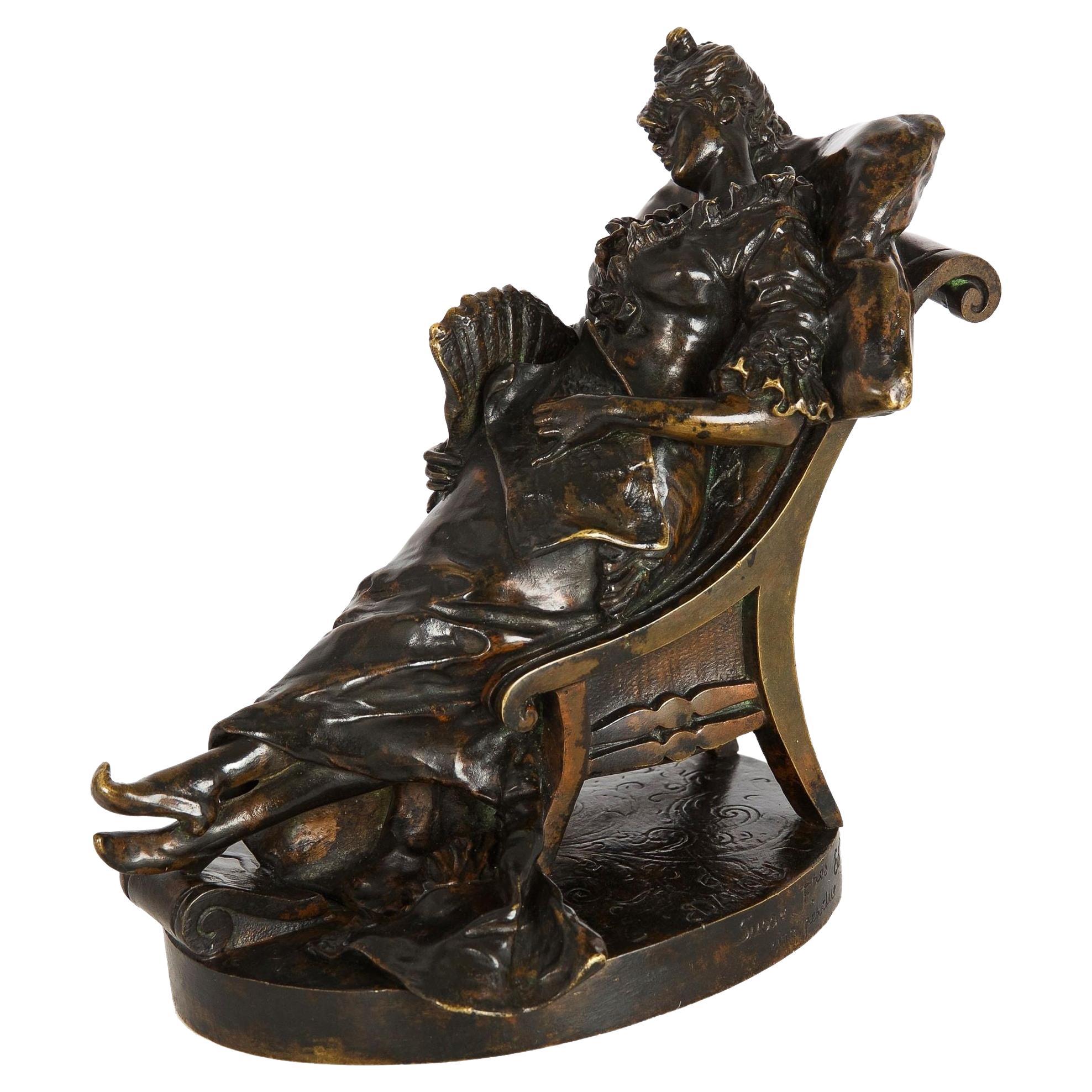Items Similar to Antique Large Bronze of Pan Dancing Musee de Naple, 1870s
Want more images or videos?
Request additional images or videos from the seller
1 of 20
Antique Large Bronze of Pan Dancing Musee de Naple, 1870s
About the Item
This is a large French Grand Tour bronze sculpture of Pan the Roman fertility God of the forest issued by the "Musee de Naple" , circa 1870 in date.
The sculpture features Pan dancing naked, he has horns, flowing hair and a tail. The statue rests on a rectangular bronze base with is signed "Musee de Naple".
The attention to detail is absolutely fantastic and the sculpture is extremely life-like.
Condition:
In really excellent condition, please see photos for confirmation.
Dimensions in cm:
Height 53 x Width 22 x Depth 15
Dimensions in inches:
Height 1 foot, 9 inches x Width 9 inches x Depth 6 inches
Pan
The culture of Ancient Greece involved a complex spiritual world of major and minor gods that oversaw human events and engaged in dramas of their own. One of these, called Pan, ruled over nature and pasturelands. He is frequently depicted in literature and artworks. Although he is not one of the major gods of Ancient Greece, he is one of most often referenced figures in Greek mythology.
Pan the God of the Wild
Pan is considered to be one of the oldest of GREEK GODS. He is associated with nature, wooded areas and pasturelands, from which his name is derived. The worship of Pan began in rustic areas far from the populated city centers. Therefore, he did not have large temples built to worship him. Rather, worship of Pan centered in nature, often in caves or grottos. He ruled over shepherds, hunters and rustic music. He was the patron god of Arcadia. Pan was often in the company of the wood nymphs and other deities of the forest.
Pan’s Appearance
Perhaps because of his association with nature and animals, Pan did not have the appearance of a normal man. The bottom half of his body was like a goat, with the top half of his body being like other men. However, he is often depicted with horns on his head, and his face is usually unattractive.
Pan’s Lineage
The parentage of Pan is uncertain. Some accounts say he is the son of HERMES and Dryope. Others say he is the son of ZEUS or the son of Penelope, wife of Odysseus. The story of his birth says that his mother was so distressed by his unusual appearance that she ran away, but he was taken to Mount Olympus where he became the favourite of the gods.
Pan’s Powers
Like the other GODS OF OLYMPUS, Pan possessed enormous strength. He could also run for long periods of time and was impervious to injury. It was believed he could transform objects into different forms and was able to teleport himself from Earth to Mount Olympus and back. He is depicted as very shrewd with a wonderful sense of humour.
In Ancient Roman mythology, a SIMILAR GOD is called Faunus.
Pan and Music
The MYTHOLOGICAL STORIES involving Pan usually involve his romantic interest in a lovely goddess of the woods who spurns his advances and gets turned into an inanimate object to escape him or who otherwise flees from his ugly appearance. One story concerns Syrinx, a beautiful wood nymph. She flees from Pan’s attentions, and her follow goddesses turn her into a river reed in order to hide her from him. As the winds blow through the reeds, they make a gentle musical sound. Because he does not know which reed Syrinx is, he cuts several from reeds from the group and set them in a line to make the musical instrument, the pan flute. Pan’s image is often depicted with this instrument.
Pan Gave Humans the Word “Panic”
One story involving Pan is the tale of war, in which Pan helps his friend survive a vicious struggle by letting out an immense cry that frightened the enemy and caused him to run away. From this story, we get the word “panic,” the sudden, uncontrollable fear that leads people into irrational behavior.
Pan in the Modern World
Over the ages, Pan has been a symbol of the force of nature. In the 1800s, interest in this mythological figure revived, and communities organized festivals in which Pan was the central figure. Mythical stories of his antics abound, and he continues to be a figure representing the ancient mystery of the forest, hunting activities and wildlife.
Like the OTHER GODS of Ancient Greece, Pan embodies many of the qualities of the world over which he ruled. He is depicted as energetic, sometimes frightening, with the wild, unbridled creative force of nature that makes him an interesting, and often entertaining, character.
Our reference: A3528
- Dimensions:Height: 20.87 in (53 cm)Width: 8.67 in (22 cm)Depth: 5.91 in (15 cm)
- Style:Grand Tour (In the Style Of)
- Materials and Techniques:
- Place of Origin:
- Period:
- Date of Manufacture:Circa 1870
- Condition:
- Seller Location:London, GB
- Reference Number:
About the Seller
5.0
Platinum Seller
These expertly vetted sellers are 1stDibs' most experienced sellers and are rated highest by our customers.
Established in 1983
1stDibs seller since 2012
1,199 sales on 1stDibs
Typical response time: <1 hour
Associations
LAPADA - The Association of Arts & Antiques Dealers
- ShippingRetrieving quote...Ships From: London, United Kingdom
- Return PolicyA return for this item may be initiated within 14 days of delivery.
More From This SellerView All
- Vintage Large Abstract Bronze Sculpture of a Dancer 20th CLocated in London, GBThis is a large stunning bronze abstract sculpture of a dancer from the last quarter of the 20th century. The naked female figure is represented in a dancing pose on a stepped cyl...Category
1990s Abstract Sculptures
MaterialsBronze
- Antique Grand Tour Patinated Bronze Figure of Narcissus 1870, 19th CenturyLocated in London, GBThis is a superb antique Grand Tour patinated bronze figure of Narcissus, dating from the last quarter of the 19th Century. Narcissus was a hunter in Greek mythology and he was di...Category
Antique 1870s Figurative Sculptures
MaterialsBronze
- Antique Pair of French Bronze Marly Horses Sculptures by Cousteau 19th CenturyLocated in London, GBThis is a fine antique pair of French Grand Tour patinated-bronze sculptures of the Marly Horses, Circa 1850 in date and signed to one base. The original Marly Horses were commissi...Category
Antique 1850s French Grand Tour Figurative Sculptures
MaterialsBronze
- Antique Grand Tour Bronze Sculpture of Goddess Diana by Mercié 19th CenturyLocated in London, GBAn elegant French Grand Tour bronze figure of the Greek Goddess Diana by Marius-Jean-Antonin Mercié, French 1845 - 1916, dating from Circa 1880. The seated and robed Goddess Diana is holding a bow and arrows with her head downcast and raised on a circular plinth. Diana was originally considered to be a goddess of the wilderness and of the hunt, a central sport in both Roman and Greek culture. Early Roman inscriptions to Diana celebrated her primarily as a huntress and patron of hunters. Add a beautiful classical element to your home with this delightful bronze. Condition: In excellent condition with no dings, dents or signs of repair. Please see photos for confirmation. Dimensions in cm: Height 41 x Width 29 x Depth 19 Dimensions in inches: Height 1 foot, 4 inches x Width 11 inches x Depth 7 inches Mercié entered the École des Beaux-Arts, Paris, and studied under Alexandre Falguière and François Jouffroy, and in 1868 gained the Grand Prix de Rome at the age of 23. His first great popular successes were the David and Gloria Victis, which was shown and received the Medal of Honour of the Paris Salon. The bronze was subsequently placed in the Square Montholon. The bronze David...Category
Antique Early 1800s French Grand Tour Figurative Sculptures
MaterialsBronze
- Antique Pair Ormolu Mounted Armchairs Empire Revival 1870sLocated in London, GBThis is a fantastic and highly decorative antique pair of French ormolu mounted mahogany Empire fauteuil armchairs, circa 1870 in date. They feature scrolled square padded backs mou...Category
Antique 1870s Armchairs
MaterialsOrmolu
- Vintage Art Deco Bronze Dancing Girl After Chiparus Mid 20th CLocated in London, GBThis is an eye-catching Vintage Art Deco Revival bronze dancing girl dating from the mid 20th century. This beautiful piece is a 20th Century recast of a sculpture created by the famous Romanian sculptor Demetre Chiparus. Made by the classical lost wax, or 'cire perdue', method, the stautue stands on a black marble base. Condition: In excellent condition, please see photos for confirmation. Dimensions in cm: Height 50 x Width 22 x Depth 16 & Weight 6 kg Dimensions in inches: Height 1 foot, 8 inches x Width 9 inches x Depth 6 inches & Weight 13.2 lbs Lost Wax Method sometimes called by the French name of cire perdue or the Latin, cera perduta is the process by which a bronze or brass is cast from an artists sculpture. In industrial uses, the modern process is called investment casting. An ancient practice, the process today varies from foundry to foundry, but the steps which are usually used in casting small bronze sculptures in a modern bronze foundry are generally quite standardised. Demetre H. Chiparus was born in Romania in 1886, attended school in Italy, then, shortly before World War I moved to Paris. He attended school at the Ecole des Beaux Arts under two talented sculptors Anonin Mercier and Jean Boucher, who provided him the opportunity to learn the trade. He later began to experiment with small bronze sculptures and produce small bronze works, exhibiting his small sculptures and, in 1914, was awarded an honorable mention at the Salon of the Societe des Artistes Francais. Many of Paris’ most affluent began to take notice of his work after World War One and the demand for his sculptures quickly increased. Chiparus was captivated by dancers, in particular influenced by Diaghiley’s Ballets Russes and Leon Bakst’s stage designs. A few of his famous sculptures were Starfish Dancer...Category
Vintage 1950s Art Deco Figurative Sculptures
MaterialsBronze
You May Also Like
- Antique Bronze Doré Miniature Bust, Smile of Reims Angel, Signed, Gilded, 1870sLocated in Greven, DEAntique miniature bust of "The Smile of Reims", in original: "L´Ange au Sourire" or "Sourire de Reims". This bronze represents the smiling angel of Reims. The Smiling of Reims is a ...Category
Antique 1870s French Victorian Busts
MaterialsMarble, Bronze, Gold Plate
- Large 1870s Bronze Classical TazzaLocated in Tarrytown, NYLarge 1870s bronze classical tazza.Category
Antique 1870s Decorative Bowls
MaterialsBronze
- Large Bronze Grand Tour Statue of PanLocated in New York, NYStanding figure of nude pan playing pipes. After the antique.Category
Antique 19th Century Italian Figurative Sculptures
MaterialsBronze
- Pair of 1870s English Carved Wood LionsLocated in Tarrytown, NYPair of 1870s English carved wood lions.Category
Antique 15th Century and Earlier Animal Sculptures
MaterialsWood
- Antique Thai Bronze Sculpture of a DancerLocated in Lambertville, NJAn antique bronze figure of a Thai dancer. The patinated and gilt bronze surface, all original. In very good condition with original aged finish. The female dancer with traditional c...Category
Early 20th Century Thai Sculptures and Carvings
MaterialsBronze
- Rare 1870s French Bronze Sculpture "Sleeping Woman" by Aimé-Jules DalouBy Aimé-Jules DalouLocated in Shippensburg, PAAIMÉ-JULES DALOU French, 1838-1902 A Sleeping Woman Patinated lost-wax cast bronze signed "DALOU" to base, inscribed "Susse Fres Edrs PARIS" and "cire p...Category
Antique 19th Century French Romantic Figurative Sculptures
MaterialsBronze
Recently Viewed
View AllMore Ways To Browse
Ancient Greek Hermes Statue
Indian Sculpture Indian Sculpture Bronze
Neoclassic Terracotta
Sculptural Fountain
Martel Brothers
Figurine By Arabia
Life Size Carved Angles
Cheyenne Remington
Herend Statue
Hermes Scepter
Neapolitan Camel
Perfume By Erte
Rick Rowley
Susanna In The Bath Marble Statue
Theodor Stundl
Tiffany Blue Nile
Totem Pole Bottle Opener
William Of Orange Nieuwerkerke





